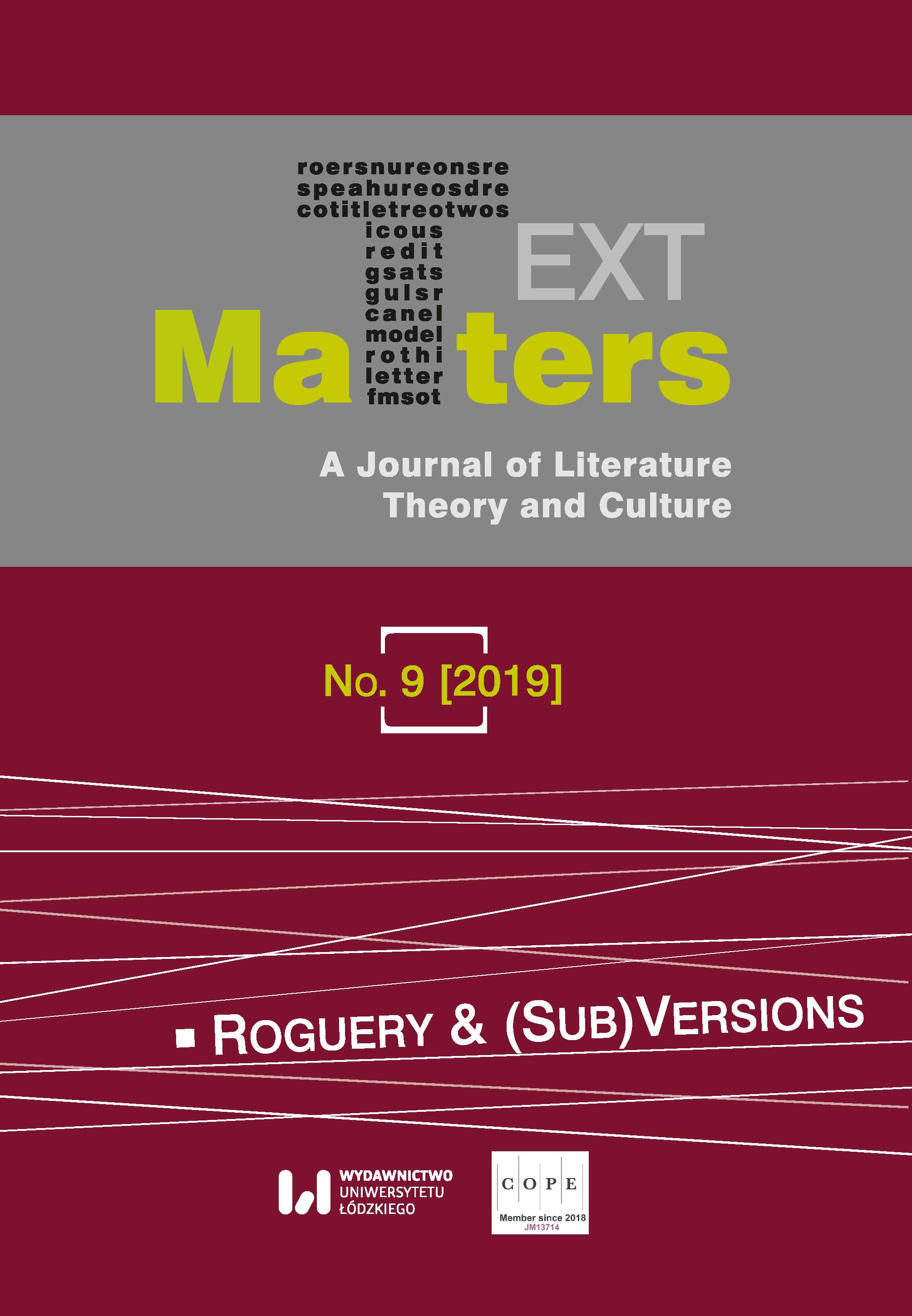“Let me hear Thy voice”: Michèle Roberts’s Refiguring of Mary Magdalene in the Light of The Song of Songs
DOI:
https://doi.org/10.18778/2083-2931.09.12Keywords:
Michèle Roberts, The Secret Gospel of Mary Magdalene, The Song of SongsAbstract
The article engages with the protagonist of The Secret Gospel of Mary Magdalene by Michèle Roberts, first published in 1984 as The Wild Girl. Filipczak discusses scholarly publications that analyze the role of Mary Magdalene, and redeem her from the sexist bias which reduced her to a repentant whore despite the lack of evidence for this in the Gospels. The very same analyses demonstrate that the role of Mary Magdalene as Christ’s first apostle silenced by patriarchal tradition was unique. While Roberts draws on the composite character of Mary Magdalene embedded in the traditional association between women, sexuality and sin, she also moves far beyond this, by reclaiming the female imaginary as an important part of human connection to the divine. At the same time, Roberts recovers the conjunction between sexuality and spirituality by framing the relationship of Christ and Mary Magdalene with The Song of Songs, which provides the abject saint from Catholic tradition with an entirely different legacy of autonomy and expression of female desire, be it sexual, maternal or spiritual. The intertext connected with The Song of Songs runs consistently through The Secret Gospel of Mary Magdalene. This, in turn, sensitizes the readers to the traces of the Song in the Gospels, which never quote from it, but they rely heavily on the association between Christ and the Bridegroom, while John 20 shows the encounter between the risen Christ and Mary Magdalene in the garden whose imagery is strongly suggestive of the nuptial meeting in The Song of Songs.
Downloads
References
Anderson, Pamela Sue. “Tracing Sexual Difference: Beyond the Aporia of the Other.” Sophia International. The Journal for Philosophical Theology, Cross-cultural Philosophy of Religion and Ethics 38.1 (1999): 54–73. Print.
Google Scholar
Bal, Mieke. “Sexuality, Sin and Sorrow: The Emergence of the Female Character (A Reading of Genesis 1–3).” Poetics Today 6.1/2 (1985): 21–42. Print.
Google Scholar
Bourgeault, Cynthia. The Meaning of Mary Magdalene: Discovering the Woman at the Heart of Christianity. Boulder: Shambhala, 2010. Print.
Google Scholar
Deutscher, Penelope. A Politics of Impossible Difference: The Later Work of Luce Irigaray. New York: Cornell UP, 2002. Print.
Google Scholar
Exum, Cheryl. Song of Songs: A Commentary. Louisville: Westminster John Knox, 2005. Print.
Google Scholar
Falcus, Sarah. Michèle Roberts: Myths, Mothers and Memories. Berlin: Lang, 2007. Print.
Google Scholar
Fisk, Anna. Sex, Sin, and Our Selves: Encounters in Feminist Theology and Contemporary Women’s Literature. Eugene: Wipf and Stock, 2014. Print.
Google Scholar
Fisk, Anna. “Stood Weeping Outside the Tomb: Dis(re)membering Mary Magdalene.” The Bible and Feminism: Remapping the Field. Ed. Yvonne Sherwood and Anna Fisk. Oxford: Oxford UP, 2017. 150–69. Print.
Google Scholar
Hamori, Esther J. Women’s Divination in Biblical Literature: Prophecy, Necromancy, and Other Arts of Knowledge. New Haven: Yale UP, 2015. Print.
Google Scholar
Haskins, Susan. Mary Magdalene: Myth and Metaphor. New York: Random, 2011. Print.
Google Scholar
Holy Bible: King James Version. New York: American Bible Society, 1980. Print.
Google Scholar
Howell Jolly, Penny. Picturing the “Pregnant” Magdalene in Northern Art, 1430–1550: Addressing and Undressing the Sinner-Saint. Farnham: Ashgate, 2014. Print.
Google Scholar
Karkkainen, Veli-Matti. An Introduction to the Theology of Religions: Biblical, Historical & Contemporary Perspectives. Madison: InterVarsity, 2003. Print.
Google Scholar
Landy, Francis. Paradoxes of Paradise: Identity and Difference in the Songs of Songs. Sheffield: Almond, 1983. Print.
Google Scholar
Lofenfeld Winkler, Lea, and Ramit Frenkel. The Boat and the Sea of Galilee. Jerusalem: Gefen, 2010. Print.
Google Scholar
Maisch, Ingrid. Mary Magdalene: The Image of a Woman Through the Centuries. Trans. Linda M. Maloney. Collegeville: Liturgical, 1998. Print.
Google Scholar
Mączyńska, Magdalena. The Gospel According to the Novelist: Religious Scripture and Contemporary Fiction. London: Bloomsbury, 2015. Print.
Google Scholar
McGovern, John. “The Waters of Death.” Catholic Biblical Quarterly 21.3 (1959): 350–58. Print.
Google Scholar
Pagels, Elaine. Ewangelie gnostyckie [The Gnostic Gospels]. Trans. Iwona Szuwalska. Wrocław: Purana, 2007. Print.
Google Scholar
Pope, Marvin H. The Song of Songs: The Anchor Bible. New York: Anchor Bible, 1977. Print.
Google Scholar
Roberts, Michèle. The Secret Gospel of Mary Magdalene. New York: Pegasus, 2007. Print.
Google Scholar
Rowland, Susan. “Michèle Roberts’ Virgins: Contesting Gender in Fictions, Rewriting Jungian Theory and Christian Myth.” Journal of Gender Studies 8.1 (1999): 35–42. Print.
Google Scholar
Schaberg, Jane. The Resurrection of Mary Magdalene: Legends, Apocrypha, and the Christian Testament. New York: Bloomsbury, 2004. Print.
Google Scholar
Starbird, Margaret. The Woman with the Alabaster Jar: Mary Magdalen and the Holy Grail. New York: Simon and Schuster, 1993. Print.
Google Scholar
Stievermann, Jan. Prophecy, Piety, and the Problem of Historicity: Interpreting the Hebrew Scriptures in Cotton Mather’s “Biblia Americana.” Heidelberg: Mohr Siebeck, 2016. Print.
Google Scholar
Synowiec, Jan. Na początku. Wybrane zagadnienia Pięcioksięgu. Warszawa: ATK, 1987. Print.
Google Scholar
Thompson, Mary R. Mary of Magdala: What “The Da Vinci Code” Misses. Mahwah: Paulist, 2006. Print.
Google Scholar
Wight, Fred H. Obyczaje krajów biblijnych [Manners and Customs of Bible Lands]. Trans. Robert Piotrowski. Warszawa: Vocatio, 2001. Print.
Google Scholar
Downloads
Published
How to Cite
Issue
Section
License

This work is licensed under a Creative Commons Attribution-NonCommercial-NoDerivatives 4.0 International License.













